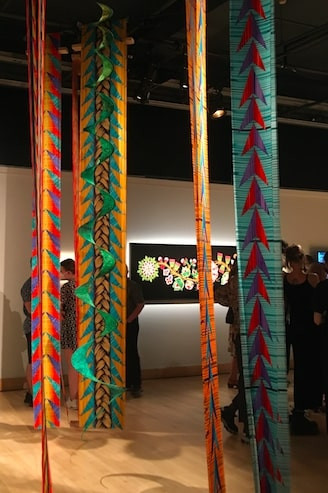Visual artist Daphne Boyer celebrates her Métis heritage with exhibition “Fa…que”
MAI features plant scientist turned artist in solo exhibition six years after having mentored her
On Sept. 7, the exhibition “Fa…que” by visual artist Daphne Boyer opened at the Montréal, Arts Interculturels. This exhibition arrived six years after Boyer, who is of Métis descent, made her debut in the art scene through the MAI’s mentorship program.
A plant scientist by training, Boyer always knew she wanted to be an artist. In 2016, she got the support of Michael Toppings from the MAI, who offered her the opportunity to be mentored by Indigenous curator and artist France Trépanier.
“France saw my work and she said, ‘Daphne, if you keep these things to yourself, you’re being selfish. Get them out and make them big’,” Boyer explained. “So six or seven years later, here I am. I’m back to say thank you to the MAI for supporting me because they launched my career and changed my life.”
The MAI acts as a pluridisciplinary art center in Montreal, but also helps artists develop their career through their mentorship programs. The mandate of this program is “to support the creation of new work and the presentation of work by people who have a multicultural practice,” explained Jaëlle Dutremble-Rivet, a production coordinator at the MAI.
The centre also places importance on their allyship to marginalized artists whom they try to assist by platforming their art. “We know that, at the level of subsidies, at the level of access and representation, there are challenges,” said Dutremble-Rivet, and we want to be a space where there are no barriers for anyone, especially for people who are systemically marginalised. [This] is a place where they are welcome.”
“It was full of annotated photographs that traced the lineage of our family. Then all this work started moving through me, it was really a very strange experience, like I was taken over by the work.” — Daphne Boyer
With the help of the MAI, Boyer has been able to develop techniques that combine plant science, photography and the traditional embellishment craft of Indigenous women to convey the stories she wants to tell.
Upon entering the exhibition room of “Fa…que”, one is immediately absorbed by the installations of colours and geometric shapes falling from the ceiling. There are collages of animal and plant forms, and fabrics printed with photos of plant matter and berries. The human is never represented in person but one always feels its presence. In fact, humanity seems to permeate the art of Boyer who seeks to transmit the kinship between nature and humans.
One work in particular catches the attention of many visitors who stand under the installation and peer at it from every angle: The Birthing Tent. With her “Berries to Beads” technique, Boyer created beaded silk ribbons with photographs of berries and high-resolution digital tools. These ribbons form four colorful corners of the tent whose velvet canopy is printed with an oxytocin molecule in the shape of a constellation. Oxytocin, explained Boyer, is the social bonding molecule that unites us with others and is especially important during childbirth.
“I hung it like a woman's bosom to make people feel like they were embraced by it,” said Boyer. The Birthing Tent was created to celebrate her great-grandmother Eleonore, who was an itinerant midwife in the Northern Great Plains. Like most of her work, this art piece reflects on the women in her life and from her Métis heritage.

With the help of her team, Boyer is able to use digital tools as well as her knowledge as a plant scientist to bring art and nature together. Using these skills, she celebrates ancestral Indigenous techniques by creating digital beading and digital porcupine quills, two materials traditionally used for embellishment.
Photographer Lina Samoukova has worked with Boyer ever since the artist started visual art and has been part of the process of developing these new techniques.
Samoukova explained that many people worked on Boyer’s creations together before they could be finalized and exhibited. “When she’s making the art, she is never making it just for herself, she is always thinking not only what impact will the art have but also, like, are we okay while we’re making it,” Samoukova said. “She cares about me and us and it’s really a labor of love.”
Boyer is now working on creating a digital version of moose tufting, another Indigenous craft, and foresees making even bigger installations. “These are scalable works because of the way they’re photographed,” she said. “I envision these works could be even bigger because I want to take up some space and say ‘Hey! Come on! Let’s review these stories and the history of what we call Canada!’”
Daphne Boyer's "Fa...que" is open for free admission from 12 p.m. to 6 p.m. on Tuesdays through Saturdays. The exhibition will run until October 8.

_600_832_s.png)

_600_375_90_s_c1.jpg)
_600_375_90_s_c1.jpg)

